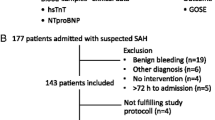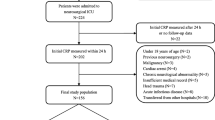Abstract
Background
Early (≤24 h) systemic procalcitonin (PCT) levels are predictive for unfavorable neurological outcome in patients after out-of-hospital cardiac arrest (OHCA). Subarachnoid hemorrhage (SAH) due to aneurysm rupture might lead to a cerebral perfusion stop similar to OHCA. The current study analyzed the association of early PCT levels and outcome in patients after SAH.
Methods
Data from 109 consecutive patients, admitted within 24 h after SAH, were analyzed. PCT levels were measured within 24 h after ictus. Clinical severity was determined using the World Federation of Neurological Societies (WFNS) scale and dichotomized into severe (grade 4–5) and non-severe (1–3). Neurological outcome after 3 months was assessed by the Glasgow outcome scale and dichotomized into unfavorable (1–3) and favorable (4–5). The predictive value was assessed using receiver operating curve (ROC) analysis.
Results
Systemic PCT levels were significantly higher in patients with severe SAH compared to those with non-severe SAH: 0.06 ± 0.04 versus 0.11 ± 0.11 μg/l (median ± interquartile range; p < 0.01). Patients with unfavorable outcome had significantly higher PCT levels compared to those with favorable outcome 0.09 ± 0.13 versus 0.07 ± 0.15 ng/ml (p < 0.01). ROC analysis showed an area under the curve of 0.66 (p < 0.01) for PCT, which was significantly lower than that of WFNS with 0.83 (p < 0.01).
Conclusions
Early PCT levels in patients with SAH might reflect the severity of the overall initial stress response. However, the predictive value is poor, especially compared to the reported predictive values in patients with OHCA. Early PCT levels might be of little use in predicting neurological outcome after SAH.


Similar content being viewed by others
References
Muroi C, Seule M, Mishima K, Keller E. Novel treatments for vasospasm after subarachnoid hemorrhage. Curr Opin Crit Care. 2012;18:119–26.
Macdonald RL, Higashida RT, Keller E, et al. Clazosentan, an endothelin receptor antagonist, in patients with aneurysmal subarachnoid haemorrhage undergoing surgical clipping: a randomised, double-blind, placebo-controlled phase 3 trial (CONSCIOUS-2). Lancet Neurol. 2011;10:618–25.
Sehba FA, Pluta RM, Zhang JH. Metamorphosis of subarachnoid hemorrhage research: from delayed vasospasm to early brain injury. Mol Neurobiol. 2011;43:27–40.
Caner B, Hou J, Altay O, Fuj M 2nd, Zhang JH. Transition of research focus from vasospasm to early brain injury after subarachnoid hemorrhage. J Neurochem. 2012;123(Suppl 2):12–21.
Fries M, Kunz D, Gressner AM, Rossaint R, Kuhlen R. Procalcitonin serum levels after out-of-hospital cardiac arrest. Resuscitation. 2003;59:105–9.
Hayashida H, Kaneko T, Kasaoka S, et al. Comparison of the predictability of neurological outcome by serum procalcitonin and glial fibrillary acidic protein in postcardiac-arrest patients. Neurocrit Care. 2010;12:252–7.
Stammet P, Devaux Y, Azuaje F, et al. Assessment of procalcitonin to predict outcome in hypothermia-treated patients after cardiac arrest. Crit Care Res Pract. 2011;2011:631062.
Muroi C, Hugelshofer M, Seule M, et al. Correlation between systemic inflammatory parameter, occurrence of delayed neurological deficits and outcome after aneurysmal subarachnoid hemorrhage. Neurosurgery. 2013;72:367–75.
Oconnor E, Venkatesh B, Mashongonyika C, Lipman J, Hall J, Thomas P. Serum procalcitonin and C-reactive protein as markers of sepsis and outcome in patients with neurotrauma and subarachnoid haemorrhage. Anaesth Intensive Care. 2004;32:465–70.
Drake CG. Report of World Federation of Neurological Surgeons Committee On a Universal Subarachnoid Hemorrhage Grading Scale. J Neurosurg. 1988;68:985–6.
Fisher CM, Kistler JP, Davis JM. Relation of cerebral vasospasm to subarachnoid hemorrhage visualized by computerized tomographic scanning. Neurosurgery. 1980;6:1–9.
Lerch C, Yonekawa Y, Muroi C, Bjeljac M, Keller E. Specialized neurocritical care, severity grade, and outcome of patients with aneurysmal subarachnoid hemorrhage. Neurocrit Care. 2006;5:85–92.
Keller E, Krayenbuhl N, Bjeljac M, Yonekawa Y. Cerebral vasospasm: results of a structured multimodal treatment. Acta Neurochir Suppl. 2005;94:65–73.
Becker KL, Snider R, Nylen ES. Procalcitonin assay in systemic inflammation, infection, and sepsis: clinical utility and limitations. Crit Care Med. 2008;36:941–52.
Seule MA, Muroi C, Mink S, Yonekawa Y, Keller E. Therapeutic hypothermia in patients with aneurysmal subarachnoid hemorrhage, refractory intracranial hypertension, or cerebral vasospasm. Neurosurgery. 2009;64:86–92.
American College of Chest Physicians/Society of Critical Care Medicine Consensus Conference. Definitions for sepsis and organ failure and guidelines for the use of innovative therapies in sepsis. Crit Care Med. 1992;20:864–74.
Tong HS, Liu YS, Wen Q, Tang YQ, Yuan FF, Su L. Serum procalcitonin predicting mortality in exertional heatstroke. Emerg Med J. 2012;29:113–7.
Adrie C, Adib-Conquy M, Laurent I, et al. Successful cardiopulmonary resuscitation after cardiac arrest as a “sepsis-like” syndrome. Circulation. 2002;106:562–8.
Adrie C, Laurent I, Monchi M, Cariou A, Dhainaou JF, Spaulding C. Postresuscitation disease after cardiac arrest: a sepsis-like syndrome? Curr Opin Crit Care. 2004;10:208–12.
Fries M, Stoppe C, Brucken D, Rossaint R, Kuhlen R. Influence of mild therapeutic hypothermia on the inflammatory response after successful resuscitation from cardiac arrest. J Crit Care. 2009;24:453–7.
Nornes H, Magnaes B. Intracranial pressure in patients with ruptured saccular aneurysm. J Neurosurg. 1972;36:537–47.
Grote E, Hassler W. The critical first minutes after subarachnoid hemorrhage. Neurosurgery. 1988;22:654–61.
Kamiya K, Kuyama H, Symon L. An experimental study of the acute stage of subarachnoid hemorrhage. J Neurosurg. 1983;59:917–24.
Asano T, Sano K. Pathogenetic role of no-reflow phenomenon in experimental subarachnoid hemorrhage in dogs. J Neurosurg. 1977;46:454–66.
Dorsch N, Branston NM, Symon L, Jakubowski J. Intracranial pressure changes following primate subarachnoid haemorrhage. Neurol Res. 1989;11:201–4.
Jain R, Deveikis J, Thompson BG. Management of patients with stunned myocardium associated with subarachnoid hemorrhage. AJNR Am J Neuroradiol. 2004;25:126–9.
Macdonald RL, Pluta RM, Zhang JH. Cerebral vasospasm after subarachnoid hemorrhage: the emerging revolution. Nat Clin Pract Neurol. 2007;3:256–63.
Author information
Authors and Affiliations
Corresponding author
Rights and permissions
About this article
Cite this article
Muroi, C., Lemb, J.B., Hugelshofer, M. et al. Early Systemic Procalcitonin Levels in Patients with Aneurysmal Subarachnoid Hemorrhage. Neurocrit Care 21, 73–77 (2014). https://doi.org/10.1007/s12028-013-9844-z
Published:
Issue Date:
DOI: https://doi.org/10.1007/s12028-013-9844-z




